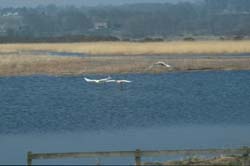
FARMERS and wildlife have been intricately linked for thousands of years. It has not always been an easy relationship, but now farmers have the opportunity to support wildlife interests so that both may continue to prosper.
At Mains of Dun Farm near Montrose, Grant Baird - a fifth generation farmer - discovered how he can make fuller use of his land which not only provides him with a financial return but also provides excellent breeding grounds for wetland birds and wildlife.
The Montrose Basin is internationally important for wildfowl and waders and is a Local Nature Reserve and designated SSSI. Mains of Dun Farm, located at the western end of the Basin, has a profound influence on how the site is managed and developed for the future.
"We all know how farming has changed in recent times," said Grant Baird. "As important as it is to sow when it's dry, it is now just as important to know the intimate details of the Scottish Executive Environmental & Rural Affairs Department's subsidy calendar! So when the National Trust for Scotland and the Scottish Wildlife Trust brought details of the new Rural Stewardship Scheme to my kitchen table I listened, as I felt I could no longer be sceptical of environmental initiatives."
The scheme is a rural development initiative designed to encourage farmers to farm in a way that takes account of the needs of wildlife and the environment. To enter, an environmental audit must be carried out and a five-year plan submitted which demonstrates how the farm's environmental credentials can be improved.
The proposal submitted on behalf of Mains of Dun Farm included some radical changes to the way the farm was run. It proposed: flooding 17 acres of arable land to create wetland, creating 6m grass water margins round 2km of ditches, 3m grass beetle banks round many fields, not spraying some crop headlands, planting 400 meters of hedges, improving 60 acres of permanent pasture for wading birds, mowing hay grass late, erecting some 1.5km of stock fence, sowing crops and leaving them un-harvested and the exclusion of cattle from certain areas during the nesting season - all done to improve the farm's wildlife habitats and add to the core of the Local Nature Reserve.
All this work was achieved with the help and support of the National Trust for Scotland, the Farming and Wildlife Advisory Group and the Scottish Wildlife Trust. The House of Dun and the western part of the Montrose Basin Local Nature Reserve, which includes the tenanted Mains of Dun Farm, was donated into NTS's care in 1980.
Richard Luxmoore, the Senior Nature Conservation Adviser for the National Trust for Scotland, said "The Trust's primary objective is to protect and promote Scotland's natural and cultural heritage for everyone to enjoy. Many of our properties, such as St Kilda, are managed as nature reserves, but on farmland we have the dual objectives of ensuring that our tenants can continue to make a living while benefiting wildlife as much as possible. We are therefore very keen to promote the opportunities offered by the Rural Stewardship Scheme."
The work at Mains Dun Farm is now underway. Arable fields have been flooded creating a natural habitat for significant species of wetland birds and waders. It can be seen as the start of a change of emphasis for Grant Baird's farming policy.
"As ever, the relationship between farmers and wildlife is inter-dependant. Without each other we will both cease to exist. In the future, as existing subsidies change from food production to provision of environmental benefits, all farmers will have a "wildlife experience" and will be paid for it. So embracing change now is the key for securing farm aid in the future. By making this decision, we will go a long way to saving our souls as well as our existence."
